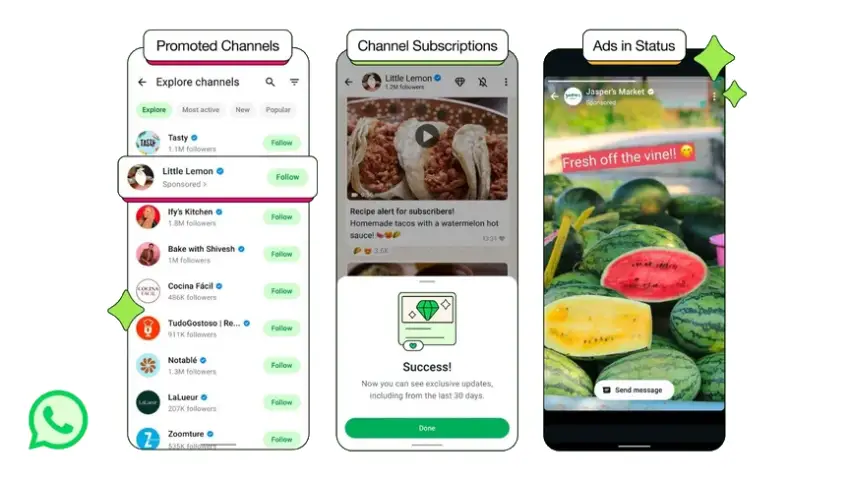The new WhatsApp update brings ads: Discover the pros and cons before hitting "Update"

WhatsApp Enters the World of Advertising Gradually After Years of Rejection
A Strategic Move by Meta
WhatsApp, a platform owned by Meta, has announced the gradual introduction of advertisements within the "Updates" tab, which includes "Status" and "Channels" features. This decision comes after years of the platform emphasizing its commitment to remaining ad-free.
Despite this shift, WhatsApp emphasized that ads will not impact users' personal chat experience, as those conversations will remain completely free from any advertising content.
Where Will Ads Appear on WhatsApp?
Ad Placement
The company confirmed that advertisements will appear only in:
-
Status section
-
Channels section
Ads will not be shown in:
-
Private chats
-
Voice or video calls

Preserving Privacy: End-to-End Encryption Still in Place
Full Protection of Conversations
WhatsApp reaffirmed its commitment to end-to-end encryption, which ensures that:
-
The content of messages and calls is only visible to the participants involved.
-
No external party, including WhatsApp itself, can access or use the content for advertising purposes.
What Kind of Data Do Ads Rely On?
No Use of Sensitive Personal Data
WhatsApp clarified that it does not use any of the following for advertising purposes:
-
Message or call content
-
Precise location data
-
Contact lists
-
Private group memberships
Data Used for Ad Targeting
Instead, WhatsApp relies on non-personal information to tailor ads, such as:
-
Country code
-
Age (if provided)
-
Language set on the device
-
City or country (without precise location tracking)
Additionally, WhatsApp considers a user’s activities within the "Updates" tab, such as:
-
The channels they follow
-
The type of content they engage with
-
Ads they click on
Integration with the Accounts Center
Customizing Ads by Linking Accounts
If a user links their WhatsApp account with the Meta Accounts Center, which includes:
-
Facebook
-
Instagram
Then information from these accounts may be used to further personalize ad experiences.
Protecting Data During Sharing
WhatsApp emphasized that data sharing with Meta is not automatic. Instead, it uses techniques such as:
-
Encrypting or anonymizing personal data like phone numbers
-
Serving ads to general audience segments based on common characteristics rather than individual identification
Ad Control Tools: Transparency First
Why Am I Seeing This Ad?
WhatsApp provides a tool called "Why I see this Ad?", which:
-
Explains why a specific ad is being shown
-
States that targeting may be based on the user’s country, language, or in-app activity
Additional Control Tools
Users can:
-
View a history of ads and advertisers recently shown
-
Customize the types of ads they see
-
Hide or report unwanted ads
-
Provide feedback to improve the ad experience
Background and Future Direction
From Strict Privacy to a New Revenue Model
WhatsApp has long promoted itself as a privacy-focused platform. However, this entry into advertising may challenge its longstanding image, putting the platform in a position where it must balance privacy with revenue generation.
Previous Revenue Sources
Before implementing in-app ads, WhatsApp’s income came from:
-
The WhatsApp Business Platform, a paid service for businesses
-
Ads on Facebook and Instagram that redirect users to WhatsApp conversations
Statement from WhatsApp’s Director
In late 2023, Will Cathcart, WhatsApp’s director, revealed that the platform was seriously considering introducing ads in:
-
Status updates
-
Broadcast Channels
He also affirmed that personal chats will remain ad-free, as that is not a suitable approach for monetizing the platform—a commitment that continues to be upheld.
Pros of the New WhatsApp Update (Ad Integration)
1. Maintaining Privacy in Personal Chats
-
Ads do not appear in personal chats or calls.
-
End-to-End encryption remains active, protecting the content of messages.
2. Ads Limited to Non-Sensitive Sections
-
Ads are shown only in "Status" and "Channels".
-
Users can simply ignore these sections if they are not interested.
3. Non-Intrusive, Contextual Advertising
-
Ads are based on general data like country and language, not on message content.
-
Precise location, friend lists, or contacts are not used for targeting.
4. Ad Control Options
-
Users can see why a specific ad was shown to them.
-
Tools are available to hide or report unwanted ads.
-
A history of ads and advertisers is accessible for user review.
5. Integration with Meta Accounts Center
-
Personalized ad experience for users who link their WhatsApp to Facebook or Instagram through Meta's Accounts Center.
Cons of the New WhatsApp Update (Ad Integration)
1. Changes the Simplicity of the User Experience
-
Even limited ad placement may impact the app’s clean and distraction-free feel.
2. Concerns About Future Privacy
-
Despite assurances, some users may feel uneasy about ads entering a platform known for its privacy.
3. Potentially Distracting Ads in "Status"
-
Users who frequently view friends’ statuses may begin to encounter ads in between.
4. Linking Accounts May Reduce Privacy
-
Using the Accounts Center and sharing data with Meta—even if encrypted—may not be ideal for all users.
5. Opens the Door to More Ads in the Future
-
Ads appearing now in the “Updates” section could lead to expanded ad placements later, raising concerns for privacy-focused users.
Conclusion
WhatsApp’s decision to introduce ads marks a significant shift in its strategy, signaling a new approach to generating revenue without directly compromising user privacy. By offering transparent tools and maintaining encrypted, secure conversations, the platform aims to satisfy both users and advertisers.
Nevertheless, the success of this initiative will largely depend on WhatsApp’s ability to maintain the trust it has built over the years.